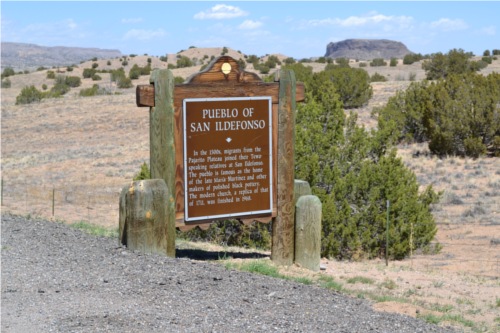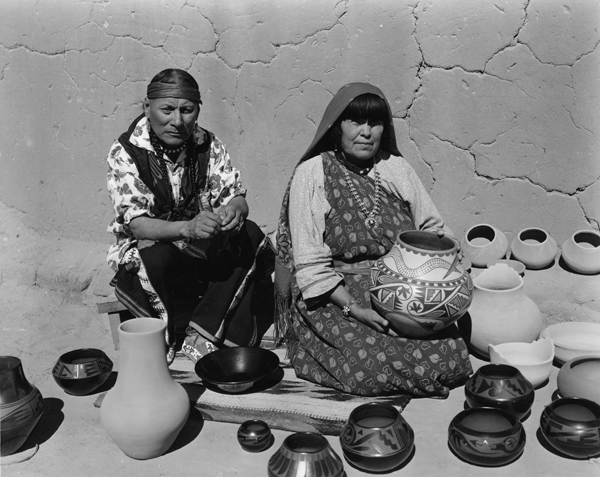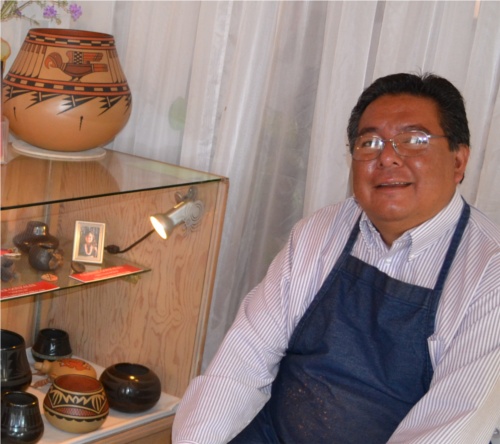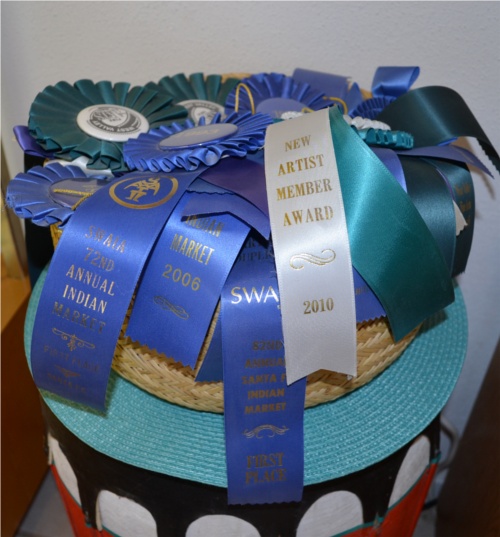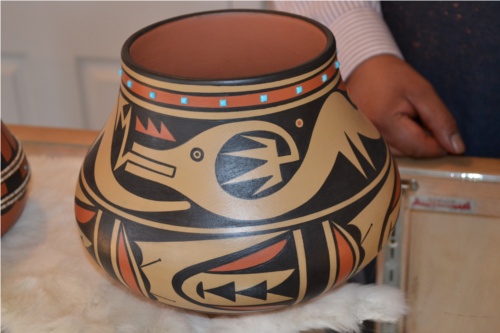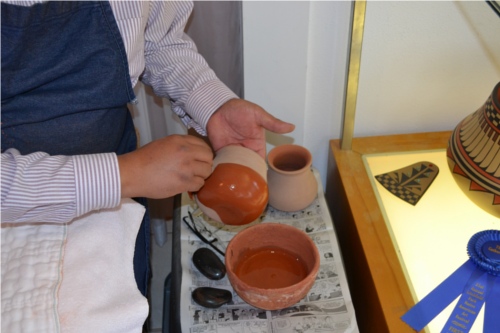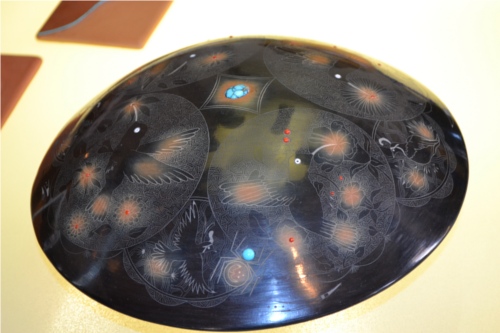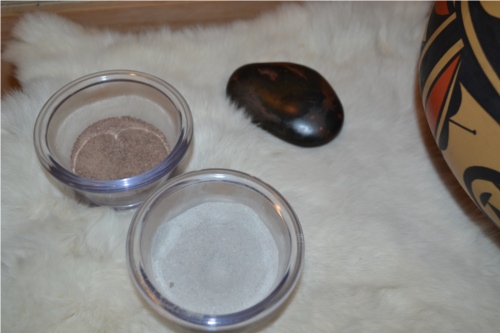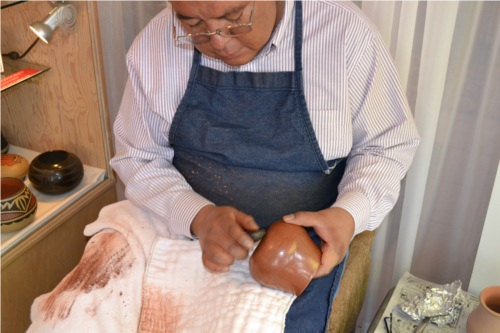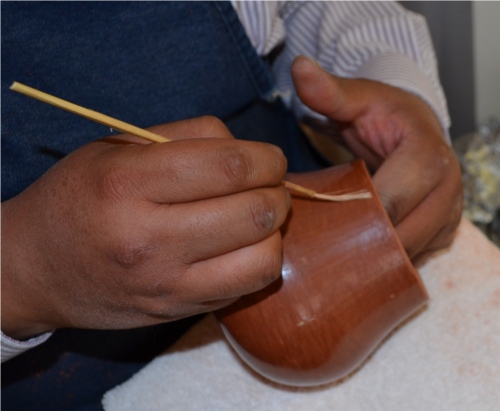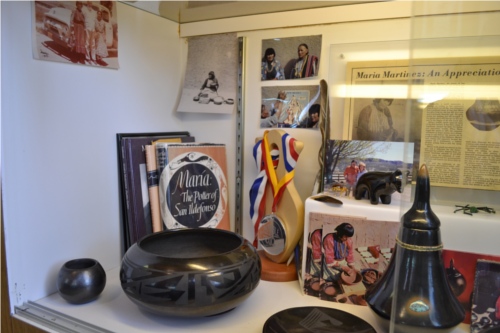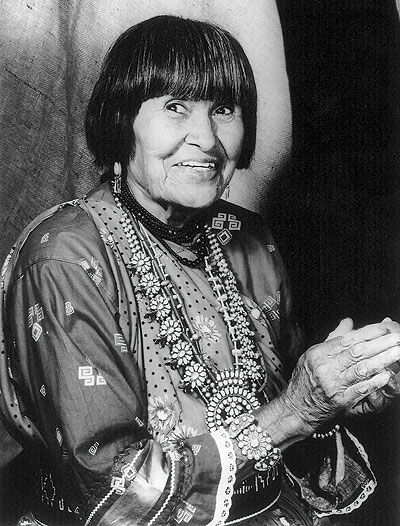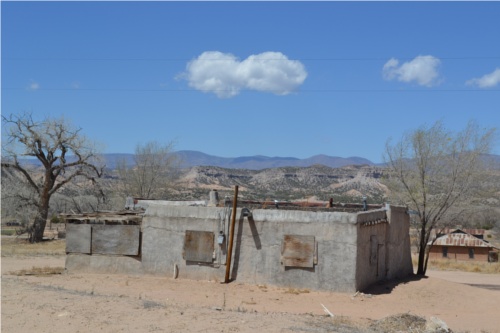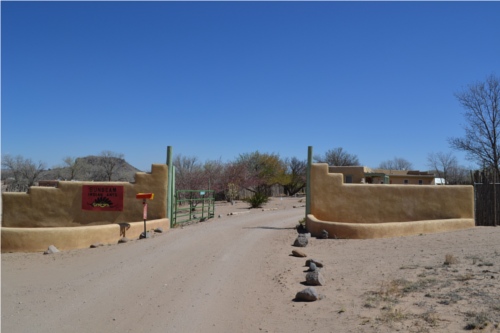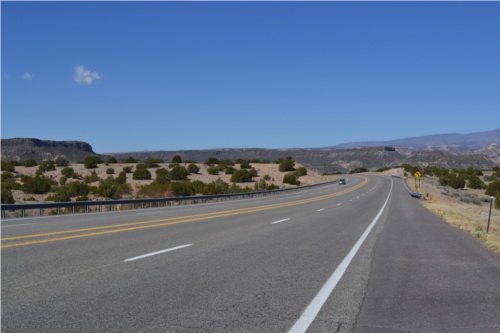San Ildefonso Pueblo is a short and easy 25-30 minute drive north of Santa Fe. The Native Tewa name of Po Woh Geh Oweenge means “Where the Water Cuts Through.” It is home to many Native American artists but the names of Maria and Julian Martinez are two of the most famous.
Maria Montoya Martinez and Julian Martinez were two of the most highly acclaimed potters in the Southwest. They became known throughout the world for their highly polished, black on black and polychrome ceramics.
Today, their legacy lives on, not only in many collections and museum exhibits around the world, but in the art of the many generations of direct descendants they left behind. A leader of the tradition is Cavan Gonzales, Maria and Julian’s great-great-grandson, and a highly acclaimed, award-winning potter in his own right.
His Tewa name is Tse-Whang meaning “Eagle Tail,” and since he was five years old he has been winning awards in art shows and museum exhibits across the nation. In the family’s Pueblo gallery, Sunbeam Indian Arts, there’s a large, deep basket spilling over with award ribbons that members of this artistic family have won over the decades.
Like his ancestors, Cavan specializes in polychrome, black on black and black on red pottery with intricately painted motifs. He is also an established painter, with works placed in the Kennedy Center in Washington D.C, and at the New Mexico State Capital in Santa Fe. Each August, collectors travel from all over the world to buy his latest creations at the famous S.W.A.I.A. Indian Market week (August 12 -18th, 2013). This year will be no exception. Cavan has been hard at work all winter to bring a new collection into existence.
This large pot is the Avanyu (Water Serpent) Jar, and is inlaid with turquoise. The Avanyu symbolizes the importance of water to the Pueblo people. The head represents the flowing of water down an arroyo or stream, the tail marks the ripples it creates. The tongue is the symbol of the lightning of a thunderstorm, and thunderclouds are above the curves of the serpent.
Cavan prefers to work in silence and solitude. It is a deeply meditative practice that requires a lot of presence and connection with the clay. I asked how long it takes to finish a piece and he said, “The pot determines how long it needs. Sometimes it can take many months or as much as a year before it lets me know it is ready.”
On this occasion, he demonstrates the slip coat process for me. Dipping a cloth into the bright red slip, he carefully glides it across the vessel’s thirsty surface.
It is clear that pottery making is a practice of devotion for Cavan. His mother Barbara Gonzales (Tahn-Moo-Whe, Sunbeam), agrees, “Many people think we make lots and lots of pots at a time just so we can sell them, but that’s not how it works.” Barbara is Maria Martinez’s great-granddaughter. She is well-known for her beautiful, award-winning “swish pots”. The enclosed saucers hold unique stones and lightweight mementos that when stirred create a swishing sound.
Cavan gathers his own clay twice a year from the hills of the San Ildefonso reservation. This spring he’ll collect “after the winds and before the rains.” He takes the time to sift the earth at the collection site, and later he mixes it with water and the volcanic ash he has collected, to perfect its consistency. The diverse colors of the earth provide different tones of slip and paint for the designs.
Finding the right size, weight and surface smoothness of the polishing stone is also important. Cavan polishes the new slip surface to a brilliant shine.
And the blade of a yucca plant is transformed into a fine paintbrush. Its outer layer is cut away at the tip to expose the brush-like interior fibers. It takes a very steady hand to paint such intricate and exacting motifs.
In a corner of the Sunbeam Gallery, the family have a case dedicated to Maria and Julian. Photos, pots, books and memorabilia remind all visitors of the importance of the family’s heritage.
Cavan remembers his great-great-grandmother very clearly. He loved to watch her work. He was eleven years old when Maria passed away in 1980; she was 99. Barbara remembers her great-grandmother’s personality too and says, “She had a great wit and sense of humor.”
Maria’s old adobe home sits abandoned just down the road from the Gallery.
Sunbeam Indian Arts Gallery is in the family compound with convenient access from the main road off the highway, and spacious parking.
It is the first sign you see just before you enter the village. Cavan’s father Robert runs the gallery and is a wealth of information on the family and its history.
Sunbeam Indian Arts is filled with beautiful work by all members of this extraordinary family tree, all the way to Cavan’s four-year-old daughter. Visitors are welcome at the Gallery every day from 10am to 5pm (except Feast Days, Christmas and Thanksgiving Holidays). Cavan and Barbara are also available for custom lectures of their work and heritage, by appointment only. Contact Robert and Barbara for rate information at (505) 455-7202.
It is an easy and beautiful scenic drive out of Santa Fe along Highway 84/285 north 15 miles, to the state road 502 exit (direction Los Alamos). Just 5.5 miles further to the San ldefonso Pueblo sign on the right.
Anyone looking for an authentic cultural experience and genuine works of Native American art would enjoy visiting the living history at Sunbeam Indian Arts.
For more information on Cavan Gonzales and the Sunbeam Indian Arts Family, call: (505) 455 7202 or go to: http://www.santafeselection.com/galleries/sunbeam-indian-arts
What: See the New Exhibition on The Life of Maria Martinez
When: Sunday, April 28th, 2013 1:00pm- 4:00pm
Where: Millicent Rogers Museum Taos.
Cavan and Barbara Gonzales will be present. Here’s a map to the museum.
http://www.santafeselection.com/map.php?d=16&c=173&v=2226
San Ildefonso Pueblo Information:
The Pueblo Visitor Center is open 8am-5pm, and sits just a few hundred feet past the road to the gallery. Keep in mind that once in the Pueblo village, driving is not permitted. Visitors may sign in and tour the area on foot. There is a $10 per car fee. If you’re in a bus or van the fee is $25 per vehicle, plus 50 cents per passenger. There’s a camera fee of $10 also. Other fees apply if you’re sketching or taking video. To reach the Visitor Center call: (505) 455-3549.

